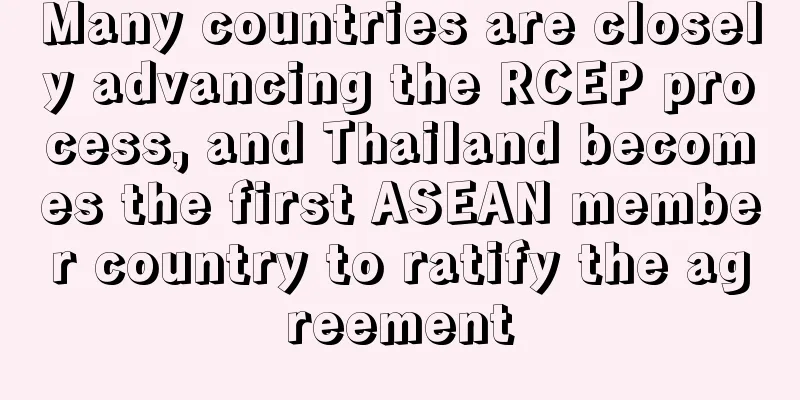Many countries are closely advancing the RCEP process, and Thailand becomes the first ASEAN member country to ratify the agreement

|
The center aims to better provide Thai people and businesses with relevant information and assistance on RCEP and other free trade agreements, trade and tariffs between Thailand and its free trade agreement partner countries. Jurin, the Thai Minister of Commerce, said at the unveiling ceremony that the formal signing of RCEP will create a huge market. At present, the member countries are stepping up the approval process , and the formal entry into force of the agreement will bring huge development opportunities to Thailand. It is understood that the RCEP negotiations were initiated by the 10 ASEAN countries in 2012, and six dialogue partner countries including Australia, China, India, Japan, South Korea and New Zealand were invited to participate. The third RCEP Leaders' Meeting was held in Bangkok, Thailand in November 2019 and issued a joint statement announcing that 15 countries except India had completed all text negotiations and substantially all market access negotiations. In November 2020, 15 RCEP member countries officially signed the agreement. At present, China has completed the approval of RCEP, and Thailand has become the first member of ASEAN to approve the agreement. However , the significance of the formal signing of RCEP is far from simple. Once RCEP is officially implemented, it will mean the birth of the world's largest free trade zone . Although RCEP currently has many member countries and has breadth, it is still not deep enough and needs further development. Judging from the development history of the European Union, RCEP can also gradually grow and develop into a model and path to lead East Asian cooperation and Asian economic integration . Judging from the current situation, RCEP has demonstrated its advantages in optimizing and upgrading the regional industrial chain. For trade in goods alone, RCEP involves reducing tariffs, eliminating non-tariff barriers and many other aspects. After the agreement comes into effect, more than 90% of the region 's trade in goods will eventually achieve zero tariffs, which will significantly reduce the cost of trade in goods and commodity prices in the region. For trade in goods, the tariff commitment tables used by RCEP contracting parties are divided into two categories. One is "unified concessions", which means applying the same tariff reduction arrangement to the same products of other contracting parties. Eight member countries, including Australia, New Zealand, Malaysia, Singapore, Brunei, Cambodia, Laos and Myanmar, adopt this model. The other type is "country-specific concessions", which means applying different tariff reduction arrangements to the same product of other contracting parties. Seven member states, namely China, South Korea, Japan, Indonesia, Vietnam, the Philippines and Thailand, have adopted this model. After becoming the first ASEAN member state to ratify the agreement, Thailand took the lead in establishing the RCEP Center, which may also mean that the day when the agreement will officially come into effect is not far away. RCEP Thailand |
<<: Amazon sued over pricing policy, to pay $2 million
>>: eBay's new announcement: SpeedPAK shipping fee adjustment notice for all routes starting April 1
Recommend
What is Shop It to Me? Shop It to Me Review, Features
Shop It to Me is a clothing store. If a piece of c...
A company under Youkeshu was declared bankrupt and liquidated!
Not only is Youkeshu itself embroiled in lawsuits...
Already reported to the police! Shenzhen freight forwarder was cheated and a large number of shipments were detained
In the first month of 2024, the freight forwardin...
What is Brightland? Brightland Review, Features
Founded in 2018 by Aishwarya Iyer, Brightland spe...
What is Haimaohui? Haimaohui Review, Features
The Overseas Trade Federation (FTF) is a cross-bo...
What is ebuycos? ebuycos Review, Features
ebuycos is an online store specializing in Hallowe...
A 32% increase! Dutch consumers spend 2.6 billion euros on online stores in 2020
According to foreign media reports, the Netherlan...
To become an excellent Amazon operator, which is more important, luck or strength?
Whether it is a company's internal assessment...
Check yourself! 200+ stores sued, this word can no longer be used...
Infringement has always been a nightmare for cros...
With a scale of US$36.09 billion, the US social commerce market has great potential
As a shopping model derived from e-commerce, soci...
Amazon's third-party sellers are losing pricing control
Amazon’s Marketplace Fair Pricing Policy explicit...
Another loser! Tongtuo gambled 900 million yuan and the difference was 100 million yuan, and the big sales bet was a mess
Recently, as listed companies have released their...
The DIY product market has broad prospects, and the Gossby brand has an average annual growth rate of 200%!
Last week , cross-border e-commerce platform Goss...
The acquisition of Yibai Network has been finalized, and more than 100 store links have been exposed...
After many twists and turns, Huakai Creative'...
What is Monreit? Monreit Review, Features
Monreit Technology Co., Ltd. is a cross-border e-c...









